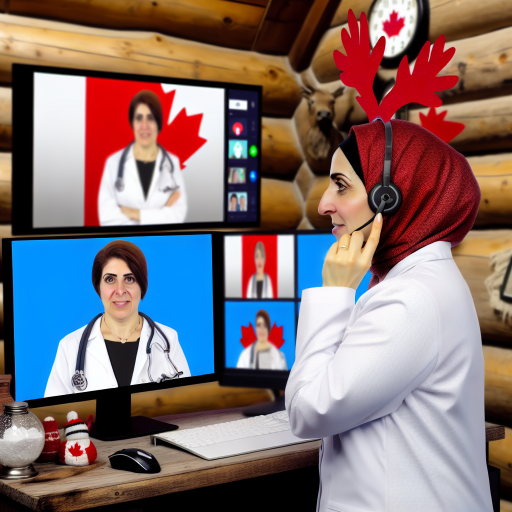Introduction
Canada’s population is aging rapidly.
Statistics Canada reports that by 2036, seniors will make up over a quarter of the population.
This demographic shift brings significant challenges to the healthcare system.
As people age, they often face chronic health conditions that require specialized care.
The increased demand for healthcare services directly relates to this growing senior demographic.
Healthcare providers must address the unique needs of older adults.
Chronic illnesses like diabetes, heart disease, and dementia become more prevalent with age.
These conditions necessitate targeted interventions and care strategies that differ from typical adult healthcare.
Additionally, many seniors experience mobility issues, cognitive decline, and social isolation, all of which require specific attention from healthcare professionals.
Implications of demographic changes on healthcare
The implications of this demographic change extend beyond acute care.
Long-term care facilities, retirement homes, and community health services all seek to adapt to the needs of an older population.
Meeting these needs requires a larger workforce equipped with the skills and training for geriatric care.
Hence, geriatric healthcare jobs become essential in responding to the growing demand for specialized services.
As the need for geriatric care grows, so does the potential for employment in this field.
Healthcare organizations actively recruit qualified professionals who understand the complexities of aging.
Careers in nursing, therapy, social work, and pharmacy tailored to older adults are gaining traction.
These roles play a critical part in enhancing seniors’ quality of life.
Furthermore, embracing geriatric healthcare jobs contributes to overall community well-being.
By focusing on preventive care and health education, these professionals empower seniors to maintain independence.
The growing emphasis on geriatric healthcare signifies a shift in society’s approach to aging.
This shift prioritizes dignity, respect, and comprehensive care for older Canadians.
In fact, Canada’s aging population poses challenges that require a robust healthcare workforce.
The increased need for geriatric healthcare professionals highlights a crucial sector in today’s job market.
Understanding the Aging Population in Canada
Canada’s demographic landscape is changing rapidly.
The population of older adults is growing significantly.
In 2020, over 18% of Canadians were seniors.
This statistic is expected to increase to 25% by 2036.
These figures indicate a dramatic shift towards an aging society.
Statistics on Current Demographics of Older Adults in Canada
- As of 2021, approximately 6.9 million Canadians were 65 years and older.
- By 2031, this number could reach 9.6 million.
- Women represent a larger percentage of seniors, at 57% of this demographic.
- The fastest-growing segment is those aged 85 and older.
- Seniors are projected to outnumber children for the first time in Canadian history by 2026.
Historical Context: Trends in Life Expectancy and Aging
Understanding the trends in life expectancy provides valuable insights.
Life expectancy in Canada has steadily increased over the past century.
In 1921, life expectancy was just 59 years for men and 60 years for women.
By 2020, these figures have risen to approximately 79 years for men and 83 years for women.
This increase in life expectancy results from various factors.
Medical advancements have played a critical role.
Improved healthcare services have led to better management of chronic diseases.
Enhanced public health initiatives, like vaccination programs, have also significantly impacted longevity.
Furthermore, socio-economic factors contribute to increased life spans.
Higher education levels and improved living standards have enabled healthier lifestyles.
Access to nutritious food and better housing also plays a crucial role.
As a result, more Canadians are enjoying longer, healthier lives.
Factors Contributing to an Increasing Elderly Population
Several key factors drive the growing elderly population in Canada.
Understanding these factors is crucial for addressing geriatric healthcare needs.
- The Baby Boomer Generation: This demographic group includes individuals born from 1946 to 1964.
As this generation ages, the senior population will increase significantly. - Advancements in Healthcare: Medical breakthroughs have transformed healthcare.
People live longer due to innovative treatments and technologies. - Declining Birth Rates: Canada’s birth rates have steadily declined.
Fewer births result in a larger proportion of older adults. - Improved Quality of Life: Enhanced living conditions contribute to longevity.
Healthier lifestyles and better healthcare access lead to improved life quality. - Increased Awareness of Senior Health Issues: There is greater recognition of seniors’ unique health challenges.
This awareness promotes preventive care and timely medical interventions.
As the population ages, understanding these drivers becomes essential.
Policymakers must create supportive environments for seniors.
Healthcare professionals must adapt to meet the unique needs of an aging population.
Future healthcare systems must prioritize geriatric care.
This approach requires investment in workforce training and developing facilities tailored to aging individuals.
Recognition of the aging population’s impact extends beyond healthcare.
It encourages community engagement and supports seniors.
Cities implement age-friendly initiatives to create inclusive environments.
Businesses must adapt to the growing senior population.
Sectors like housing, transportation, and recreational services need to cater to older adults.
Technology plays a significant role. Innovations in telehealth improve healthcare access.
Smart home technologies increase comfort and security for older adults.
Basically, Canada’s aging population presents unique challenges and opportunities.
Addressing these needs proactively ensures a healthier society for all.
Current State of Geriatric Healthcare in Canada
Canada’s geriatric healthcare landscape is evolving rapidly.
The increasing number of older adults necessitates urgent responses from healthcare systems.
This section highlights the current state of geriatric healthcare services, evaluates their adequacy, and identifies service gaps.
Overview of Existing Healthcare Services for Older Adults
Canada offers a variety of healthcare services tailored to older adults.
These services often cater to both physical and mental health needs.
The following lists some key components of the geriatric healthcare framework:
- Primary Care: General practitioners provide basic healthcare services, including preventive care and chronic disease management.
- Home Care Services: Many regions offer in-home assistance, including nursing care and personal support workers.
- Long-Term Care Facilities: Nursing homes and assisted living facilities provide supportive environments for those needing more comprehensive care.
- Hospital Services: Hospitals have specialized geriatric departments to handle acute conditions and rehabilitation.
- Community Health Programs: Various programs focus on wellness and social engagement, promoting active and healthy lifestyles.
- Palliative and Hospice Care: Specialized care ensures that older adults manage end-of-life issues with dignity and support.
- Mental Health Services: Facilities and programs address cognitive decline and mental health issues, including dementia and depression.
Despite the comprehensiveness of these services, challenges remain in effectively servicing the elderly population.
Adequacy of Current Geriatric Care Provisions
The adequacy of geriatric care provisions in Canada varies widely across regions.
Access to services significantly influences the health outcomes of older adults.
Here are several factors to consider:
- Accessibility: Geographic disparities exist, with rural areas often facing shortages of geriatric services.
- Workforce Availability: A shortage of trained geriatric healthcare professionals hampers quality of care delivery.
- Funding Limitations: Many geriatric programs receive insufficient funding, limiting their reach and effectiveness.
- Cultural Competence: Services often lack cultural sensitivity, impacting care quality for diverse populations.
- Integration of Services: Fragmented care systems lead to inefficient resource use and a lack of coordinated care.
These factors contribute to a system that often struggles to meet the growing demands of an aging population.
Identification of Gaps in Services and Care for the Elderly
Identifying service gaps is critical for improving geriatric healthcare in Canada.
Several gaps hinder effective care for older adults:
- Inadequate Preventive Care: Many seniors miss timely screenings, leading to late diagnoses.
- Lack of Specialized Programs: Few programs address frailty, fall prevention, and chronic pain management.
- Limited Mental Health Resources: Mental health services for seniors experiencing depression and anxiety remain insufficient.
- Caregiver Support Shortage: Family caregivers lack adequate resources and assistance to provide effective care.
- Transitioning Care Challenges: Poorly planned transitions from hospital to home or long-term care result in complications.
- Inaccessible Physical Spaces: Healthcare facilities often fail to accommodate older adults’ mobility and safety needs.
- Insufficient Training: Healthcare providers frequently lack specialized training for managing geriatric complexities.
Addressing these gaps requires collaboration among government bodies, healthcare providers, and community organizations.
Improved accessibility, comprehensiveness, and quality of care will enhance health outcomes for older adults.
Efforts should focus on developing programs that address medical needs while supporting mental, social, and emotional well-being.
Unlock Your Career Potential
Visualize a clear path to success with our tailored Career Consulting service. Personalized insights in just 1-3 days.
Get StartedAs demand for geriatric healthcare grows, investing in training and resources becomes essential.
A skilled workforce ensures older adults receive high-quality care, strengthening the healthcare system.
Canada must improve its geriatric care framework to address current inadequacies.
Solving these challenges requires innovation and commitment to improving seniors’ quality of life.
In short, addressing the gaps in geriatric healthcare is vital.
By enhancing care and accessibility, Canada can provide dependable, quality services for its aging population.
The focus must remain on creating a healthier future for seniors.
Read: How to Start a Career in Nursing and Thrive in Canada
The Growing Need for Geriatric Healthcare Professionals
As Canada’s population ages, the demand for geriatric healthcare professionals is skyrocketing.
This demographic shift has created an urgent need for skilled workers who specialize in caring for older adults.
The roles and responsibilities of these professionals are vital.
They ensure the well-being and quality of life for seniors across the country.
Roles and Responsibilities of Geriatric Healthcare Workers
Geriatric healthcare professionals encompass various roles.
Each professional contributes uniquely to the care of elderly patients.
Here are some key responsibilities:
- Assessment: Geriatric healthcare workers conduct thorough assessments of patients’ physical and mental health.
- Care Planning: They develop and implement individualized care plans tailored to each senior’s unique needs.
- Coordination: These professionals coordinate services with other healthcare providers to optimize patient outcomes.
- Advocacy: They advocate for patients’ rights and ensure their voices are heard in care decisions.
- Education: Geriatric professionals educate patients and families about health management and available resources.
- Support: They provide emotional and psychological support to seniors and their families during challenging times.
The range of skills required for these roles is extensive.
Geriatric healthcare workers must possess clinical skills alongside empathy and patience.
Their work is essential in helping seniors maintain independence and dignity.
Job Growth Projections in Geriatric Healthcare Fields
Job growth in the field of geriatric healthcare is unprecedented.
The aging population fuels this growth.
The Government of Canada predicts considerable increases in job opportunities.
Various sectors within geriatric healthcare will see substantial demand.
According to recent statistics:
- Nursing: The employment rate for registered nurses specializing in geriatrics is expected to grow by a significant percentage.
- Occupational Therapy: Positions for occupational therapists targeting elderly clients will also rise, meeting rehabilitation needs.
- Social Work: Social workers focusing on seniors will experience a surge in job openings in community settings.
As Canada’s senior population is projected to double by 2036, these projections underline the necessity for a dedicated workforce.
More trained professionals will ensure comprehensive support for aging Canadians.
Specific Roles in High Demand
Several specific healthcare roles are becoming increasingly vital.
These roles address the diverse needs of elderly patients.
The following professions experience the highest demand:
- Registered Nurses (RNs): RNs play a key role in hospitals and long-term care facilities.
They provide direct patient care and oversee health management. - Licensed Practical Nurses (LPNs): LPNs support RNs in providing routine care and medication administration in various settings.
- Occupational Therapists: Occupational therapists help seniors regain independence through tailored therapeutic interventions.
- Physical Therapists: Physical therapists focus on improving mobility and strength to enhance seniors’ functional abilities.
- Social Workers: Social workers assist elderly individuals with emotional support and access to community resources.
- Geriatric Care Managers: These professionals coordinate care services, advocating for seniors and their families.
- Home Health Aides: Home health aides provide essential support for seniors who wish to age in place.
The increasing existence of these roles highlights the dynamic nature of geriatric care.
Each role complements the others, creating a comprehensive support system for seniors.
Challenges and Opportunities in Geriatric Healthcare
While the growing demand for geriatric healthcare jobs presents numerous opportunities, it comes with challenges.
One significant challenge includes the shortage of healthcare workers qualified to meet these needs.
To address this issue, educational institutions are ramping up training programs.
They aim to prepare more individuals for careers in geriatrics.
Additionally, ongoing professional development is crucial in this rapidly evolving field.
Furthermore, the integration of technology in geriatric care can improve job efficiency and patient outcomes.
Training healthcare workers in telehealth and electronic records enhances their effectiveness.
This integration allows for better communication and management of senior care.
The aging population in Canada drives a significant demand for geriatric healthcare professionals.
As the number of seniors continues to rise, the urgency for trained workers in this field is evident.
Registered nurses, occupational therapists, and social workers are in high demand.
Demand will only grow as awareness of the needs of older adults continues to increase.
By recognizing the roles and responsibilities of geriatric healthcare workers, society can better support the needs of its aging population.
Investing in education, training, and technology is essential.
Ensuring a robust workforce in geriatric healthcare is vital for maintaining the health and well-being of Canada’s seniors.
The time to act is now to meet this pressing challenge head-on.
Read: Top 10 High-Demand Healthcare Careers in Canada

Challenges Faced by the Geriatric Healthcare Sector
Canada’s healthcare system faces significant challenges in catering to its aging population.
The rise in the number of elderly individuals affects the demand for geriatric healthcare jobs.
This increase in demand brings various difficulties for the sector.
Understanding these challenges is crucial for addressing the needs of both patients and healthcare professionals.
Workforce Shortages
The geriatric healthcare sector is experiencing acute workforce shortages.
Multiple factors contribute to this ongoing issue.
The aging population itself creates a rising demand for services.
However, not enough healthcare workers are available to meet these needs.
Here are some key points regarding workforce shortages:
- High Turnover Rates: Many professionals leave due to burnout and stress.
- Insufficient Training Opportunities: Few educational programs focus specifically on geriatric care.
- Aging Workforce: Many current geriatric professionals are approaching retirement age.
- Low Recruitment Rates: Fewer new graduates pursue careers in geriatric healthcare.
These factors create an enormous strain on the existing workforce.
Facilities struggle to recruit and retain skilled professionals.
As a result, patients often receive inadequate attention and care.
High Demand for Geriatric Healthcare Services
The demand for geriatric healthcare services continues to escalate.
The growing elderly population requires more specialized care than ever before.
This situation influences various aspects of the healthcare system.
Consider the following points:
- Increased Chronic Conditions: Many seniors suffer from multiple chronic illnesses requiring ongoing care.
- Longer Life Expectancy: With advancing medical technology, people live longer lives, necessitating more healthcare services.
- Complex Care Needs: The elderly often require integrated care solutions involving multiple specialties.
This rising demand highlights a crucial disconnect between patient needs and available healthcare resources.
Facilities often lack sufficient staffing to meet the growing patient load.
Implications of Inadequate Staffing on Patient Care
The ramifications of inadequate staffing in geriatric healthcare are profound.
High patient-to-staff ratios negatively impact the quality of care.
Several specific issues arise from this situation, including:
- Decreased Quality of Care: Patients may not receive adequate monitoring or attention, leading to potential complications.
- Increased Wait Times: Long wait times for appointments and procedures can worsen health outcomes for elderly patients.
- Higher Risk of Errors: Staffing shortages can increase the likelihood of medical errors, causing patient harm.
- Reduced Patient Satisfaction: Fewer staff members often lead to rushed appointments, diminishing patient experience.
These implications can substantially affect patient outcomes.
Seniors may suffer from deteriorating health due to inadequate care.
This creates a cycle of worsening health and increasing healthcare costs.
Disparity in Geriatric Training
Another challenge facing the geriatric healthcare sector is the disparity in training.
Not all healthcare education programs emphasize geriatric training.
This lack of consistent training leaves many professionals unprepared.
The following points illustrate these disparities:
- Inconsistent Curriculum: Various schools and training programs offer differing levels of geriatric education.
- Limited Clinical Experience: Many students have few opportunities to interact with elderly patients during their training.
- Lack of Credentialing: Insufficient focus on specialization makes it harder for healthcare professionals to demonstrate competency.
This lack of preparedness can have serious implications.
Healthcare providers may lack the necessary skills to address the unique needs of elderly patients.
Consequently, the quality of care suffers.
Addressing the Challenges
To tackle these challenges, targeted strategies are essential.
Stakeholders in healthcare need to prioritize geriatric workforce development.
Consider the following approaches:
- Enhancing Educational Programs: Schools should provide more geriatric-specific curricula and training opportunities.
- Promoting Geriatric Specializations: Encouraging healthcare professionals to pursue additional training in geriatrics can improve care.
- Implementing Retention Strategies: Healthcare organizations can focus on improving work conditions to reduce burnout.
- Increasing Funding: Investment in geriatric services and workforce expansion is essential for meeting demand.
These strategies can help alleviate the pressures on the geriatric healthcare sector.
By focusing on workforce development and training, Canada can ensure better care for its aging population.
Canada’s aging population presents significant challenges for the geriatric healthcare sector.
Workforce shortages and increasing demand for services strain the existing system.
As a result, patient care may suffer, which can have serious consequences.
Addressing these challenges is crucial to ensuring that the elderly receive the quality care they deserve.
Read: Public Health Outreach: Effective Strategies
Opportunities for Career Advancement in Geriatric Healthcare
The field of geriatric healthcare presents numerous opportunities for career advancement.
As Canada’s aging population continues to grow, so does the demand for skilled professionals in this sector.
The government estimates that by 2031, one in four Canadians will be over 65 years old.
This demographic shift necessitates a focus on specialized care and services.
Therefore, pursuing a career in geriatric healthcare is not only rewarding but also offers strong prospects for growth and specialization.
Educational Pathways and Specialized Training
Becoming a professional in geriatric healthcare requires an educational foundation.
Various academic programs and certifications cater specifically to this field.
Here are some common pathways:
- Undergraduate Degrees: Many professionals start with a degree in nursing, social work, or gerontology.
- Graduate Programs: Advanced degrees, such as Master of Science in Nursing (MSN) or Master of Social Work (MSW), enhance knowledge and skills.
- Specialized Certificates: Institutions offer certificates in geriatric care management or advanced geriatric nursing.
- Continuing Education: Workshops and seminars keep professionals updated with the latest developments in geriatrics.
Engaging in specialized training enhances your qualifications.
Many programs focus on the unique physical and mental health issues faced by older adults.
Training may include:
- Cognitive Disorders: Understanding Alzheimer’s and other dementia-related conditions.
- Palliative Care: Learning how to manage pain and provide comfort in end-of-life situations.
- Caregiver Support: Educating families on how to care for elderly loved ones.
Potential for Career Growth and Diversification
Geriatric healthcare professionals may explore numerous career paths.
The diversity in opportunities allows for customization of one’s career based on interests.
Some potential roles include:
- Geriatric Nurse: Specializing in nursing care for older patients in various settings.
- Geriatrician: Physicians who focus on the medical care of the elderly.
- Occupational Therapist: Helping seniors regain independence through rehabilitative care.
- Recreational Therapist: Implementing programs to improve the quality of life for seniors.
- Home Health Aide: Providing personal care and assistance in patients’ homes.
- Healthcare Administrator: Overseeing senior healthcare facilities and programs.
Moreover, professionals can specialize further within each field.
For example, a nurse could become certified in geriatric psych nursing.
This specialization expands the depth of care provided.
Success Stories in Geriatric Healthcare
Many individuals have successfully carved out rewarding careers in geriatric healthcare.
Their stories illustrate the potential for impact and fulfillment in this field.
Here are a few notable examples:
- Dr. Sarah Johnson: A geriatrician who shifted from general practice.
She now specializes in managing chronic diseases among seniors.
Dr. Johnson finds joy in improving patients’ quality of life. - Lisa Chen: A nurse who undertook additional training in geriatrics.
She now leads a nursing team focused on dementia care at a local hospital. - Mark Thompson: An occupational therapist who created innovative rehabilitation programs tailored for elderly patients.
His methods have gained national recognition. - Emily Garcia: After earning her degree in social work, she became a geriatric care manager.
Emily helps families navigate the healthcare system for their elderly relatives.
These professionals exemplify how career advancement is possible through dedication and ongoing education.
Their unique roles in geriatric healthcare significantly improve individuals’ lives.
The opportunities for career advancement within geriatric healthcare are vast.
With an increasing elderly population, Canada requires skilled and compassionate professionals.
Educational pathways, specialized training, and opportunities for diversification contribute to a robust career landscape.
Individuals can look forward to fulfilling careers with significant societal impact.
As the demand grows, so does the potential for professionals to thrive in this noble field.
Read: Career Paths: Epidemiology in Canada
The Role of Technology in Enhancing Geriatric Care
In today’s healthcare landscape, technology plays a crucial role in enhancing geriatric care.
Advancements in technology have paved the way for improved healthcare delivery tailored for the needs of the aging population.
As Canada’s demographic shifts toward an older population, the use of technology becomes essential.
Innovative solutions not only improve patient outcomes but also increase efficiency within the healthcare system.
Technological Advancements in Geriatric Healthcare
Several technological innovations are transforming the way healthcare professionals deliver services to elderly patients.
Some key advancements include:
- Electronic Health Records (EHRs): EHRs streamline patient data management.
They allow healthcare providers easy access to a patient’s medical history.
Improved data sharing enhances coordination among care teams. - Mobile Health Applications: These apps empower patients to manage their health proactively.
Features like medication reminders and appointment notifications facilitate adherence to treatment plans. - Wearable Technology: Wearable devices monitor vital signs continuously.
They alert caregivers about any significant changes in a patient’s health, promoting timely interventions. - Telehealth Services: Telehealth enables remote consultations.
Patients can connect with healthcare providers from the comfort of their homes, reducing the need for physical visits. - Assistive Devices: Technologies such as grab bars, stairlifts, and mobility aids enhance safety and independence for the elderly.
Telehealth: A Game Changer in Geriatric Care
Telehealth has gained immense popularity, especially in the wake of the COVID-19 pandemic.
This digital solution facilitates virtual appointments, ensuring continuity of care for elderly patients.
Some of the primary benefits of telehealth include:
- Access to Specialists: Telehealth breaks geographical barriers.
Seniors in remote areas now have access to specialized care. - Reduced Travel Burden: Older adults often face mobility challenges.
Telehealth minimizes the need for travel, making healthcare more accessible. - Improved Convenience: Patients can receive care without leaving their homes.
This flexibility accommodates their schedules and preferences. - Enhanced Monitoring: Regular follow-ups through telehealth ensure seniors’ health is closely monitored.
Providers can quickly adapt treatment plans based on patient feedback.
Artificial Intelligence in Geriatric Healthcare
Artificial intelligence (AI) is revolutionizing various aspects of geriatric care.
AI-driven tools facilitate decision-making and enhance patient outcomes.
Here are ways AI contributes to geriatric healthcare:
- Predictive Analytics: AI identifies patterns in patient data.
By analyzing historical data, AI can predict health issues before they escalate. - Personalized Treatment Plans: AI algorithms consider individual patient factors.
They help in crafting personalized treatment plans tailored to unique needs. - Virtual Health Assistants: AI chatbots can provide immediate responses to healthcare queries.
They improve patient engagement and support care management. - Robotic Surgery: AI enhances precision in surgical procedures.
This technology leads to better outcomes and quicker recovery for elderly patients.
Robotic Assistance in Elderly Care
Robots and automation have gained traction in elderly care settings.
These technologies offer significant help in daily activities, ensuring seniors maintain their dignity and independence.
Here’s how robotic assistance is changing geriatric care:
- Companion Robots: These robots provide social interaction.
They help reduce feelings of loneliness and isolation among seniors. - Mobility Assistance Robots: Robots designed for mobility aid help seniors move around safely.
They enhance mobility and reduce the risk of falls. - Medication Dispensing Robots: Automating medication management minimizes errors.
Seniors can receive their medications on time as prescribed. - Emergency Response Robots: These robots can alert caregivers in case of emergency situations.
They provide peace of mind for both patients and their families.
Alleviating Workforce Pressures
One of the most pressing challenges in geriatric care is workforce shortages.
As the demand for elderly care increases, technology can help alleviate these pressures.
By automating certain tasks, healthcare professionals can focus on higher-level responsibilities.
Here’s how technology addresses workforce challenges:
- Efficiency in Routine Tasks: Automating mundane tasks frees up more time for healthcare workers.
This allows them to provide better care to their patients. - Remote Monitoring: Technology enables continuous monitoring of patients’ health.
This reduces the frequency of in-person visits required by healthcare providers. - Training Tools: Virtual reality and simulation training programs prepare staff for real-world scenarios.
This enhances their skills and confidence in delivering care. - Focus on Patient-Centered Care: By reducing administrative tasks, professionals can spend more time on direct patient interactions.
This leads to better patient satisfaction and outcomes.
Improving Patient Outcomes Through Technology
The integration of technology into geriatric care directly correlates with improved patient outcomes.
When patients experience enhanced care, their overall health improves.
The benefits of technological advancements on patient health include:
- Timely Interventions: Continuous monitoring and telehealth enable timely responses to health issues.
- Increased Adherence to Treatment: Mobile health applications assist elderly patients in adhering to treatment plans.
- Reduced Hospitalizations: Predictive analytics and remote monitoring lower hospital admissions.
Patients receive care earlier, preventing complications. - Promoting Independence: Assistive devices and robotic technologies help seniors maintain their independence and dignity.
In essence, technology plays an essential role in enhancing geriatric care in Canada.
Advancements such as telehealth, AI, and robotic assistance alleviate workforce pressures while improving patient outcomes.
As the aging population grows, these technological solutions become increasingly vital in addressing the challenges faced in geriatric healthcare.
Health professionals must embrace these innovations to provide the highest quality of care for our elderly population.
Conclusion
Canada’s aging population demands immediate attention.
The rising number of seniors increases the need for specialized healthcare.
This demographic shift urges us to address pressing healthcare challenges.
Geriatric healthcare emerges as a crucial field for career opportunities.
Professionals in this area will provide essential support to the elderly.
Their expertise can greatly improve quality of life for seniors.
Encouraging careers in geriatric healthcare is vital.
We must attract talented individuals to this rewarding field.
Young professionals can change perceptions about aging and care.
They can bring innovative ideas and solutions to improve elder care.
By fostering a supportive environment, we can enhance job satisfaction in this sector.
Additionally, awareness surrounding geriatric healthcare must increase.
Society often overlooks the specific needs of the elderly.
By advocating for policy changes, we can address systemic challenges.
Governments should prioritize funding for geriatric programs and education.
Health institutions need to adapt to the evolving demographics of Canada.
Education plays a crucial role in preparing the workforce.
We must develop specialized training programs for healthcare providers.
These programs should focus on the unique needs of aging patients.
By equipping professionals with the right skills, we can ensure better care for seniors.
In general, addressing the needs of Canada’s aging population is urgent.
It involves a concerted effort from individuals, communities, and policymakers.
Together, we can build a comprehensive geriatric healthcare system.
Let’s call for awareness, advocate for policy changes, and commit to education.
By making informed choices now, we can improve the future of elder care in Canada.




